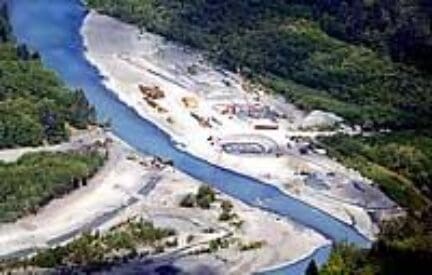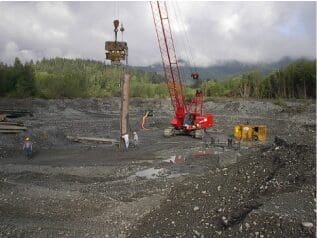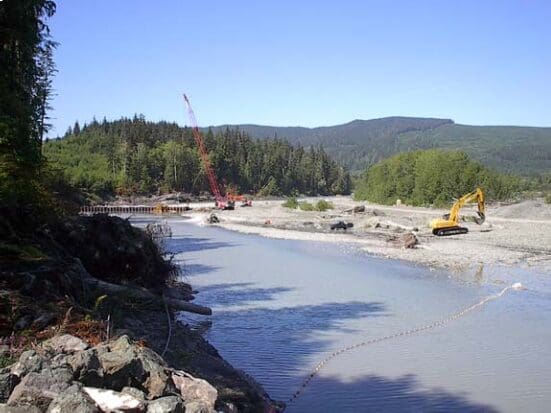Giant Logjams Built to Protect Highway
By Jim Downing
Seattle Times staff reporter
THE HOH RIVER, Jefferson County — The Hoh is the unruly teenager of Washington rivers.
And it likes to eat.

The largest engineered logjams ever constructed are being built on the Hoh River in Jefferson County in an attempt to stop the waters from eating away at U.S. Highway 101. A crew of 25 has been working seven days a week to complete the $7 million project before the fall rains.
Four times, the Federal Highway Administration has funded emergency efforts to stop the river from gobbling up a stretch of U.S. Highway 101 fifteen miles south of Forks, Clallam County. The Hoh, racing down from the glaciers of Mount Olympus, has chewed through 600 feet of bank in the past decade to the shoulder of the highway.
Last winter, the Department of Transportation placed 1,000 truckloads of rock riprap on the Hoh’s south bank to protect the highway. That held, but officials worry that the Hoh will just eat its way around the rock in the next flood, as it has done before.
Now, a Seattle scientist and state and federal highway officials are gambling their reputations and $7 million on a project to coax the Hoh away from the highway using the largest engineered logjams ever built.

The Hoh project is a bold test of a relatively new technology that employs time-tested engineering design principles to create supersized logjams. If it fails in a big flood, there’s a good chance the highway and much of the unstable hillside behind it will be washed out. Rerouting the highway would cost an estimated $40 million.
Man’s influence has made the Hoh ever more violent on its way to the Pacific. Logging has led to faster erosion of its banks and dumped tons of sediment into the river. And riprap placed along the way to shore up local roads has only quickened its flow.
“The Hoh fights back at whatever we tell it to do,” says Tim Abbe, a geomorphologist with Herrera Environmental Consultants in Seattle. “Almost every year, we lose a new section of road.”
The idea that the new super logjams will hold has many locals rolling their eyes.
A gentler approach
If dams and riprap are the straitjacket approach to taming wild rivers, engineered logjams are talk therapy — a gentler attempt to convince a river like the Hoh to flow in a new direction, without damaging its ecology in the process.
In the past century, the government favored dams and riprap. But having recognized the ecological and monetary costs of muscling rivers into place, agencies are now looking for more subtle tools to manage the coexistence of rivers and people. Engineered logjams fit the bill — fish like the habitat that logjams create.
Abbe conceived the Hoh project’s general design. He has pioneered the application of solid engineering to the design of large logjams in the U.S. and Australia. He realizes the Hoh is a make-or-break case in the use of such “natural” structures to alter a river’s flow.
The Hoh logjams will serve several distinct functions, Abbe says. Four 80-foot square logjams in a swath across the river upstream of the threatened bank will split the river’s flow. The intent is to reduce the erosive power of the Hoh on the highway embankment.
Along the bank, six triangular logjams will jut out 50 feet into the channel to prevent the river from scouring the bank. “The structures will cover the existing riprap — so instead of a sheer rock bank, we’ll have pools and cover for fish as well as riparian vegetation between the highway and the river,” Abbe says.
In order to build the logjams in the river channel, crews last week used a temporary dam to divert the Hoh into a new channel — a re-graded gravel bar where the river used to flow. Once construction is completed, the dam will be removed and the river will divide its flow between the two channels, Abbe hopes.
The logjams are built to withstand 100-year floods, with steel plates extending more than 30 feet underground and steel H-pilings sunk to almost 60 feet. The logs, 490 in all, are laced into the pilings in an interlocking pattern. The crew will fill the interstices with topsoil to help jump-start plant life.
Making history
On the construction site, Mike Utheim, the Department of Transportation’s on-site inspector, watches as workers guide a massive steel plate hanging from a crane into a hole the size of a skyscraper foundation. “It boggles my mind to see what we’re doing here,” he says.
Two cranes, four excavators, a front-loader, two bulldozers and three big dump trucks rumble around the Hoh’s gravel bed. A crew of 25 has been working seven days a week, 12 hours a day since construction started July 6.
“We’ll get it done,” says Randy Dawley, foreman for Delhur Industries, the lead contractor on the project. “And we’ll go down in the history books, one way or the other.”

The state Department of Transportation hopes to have the project finished — and the crew with its millions of dollars of equipment out of the riverbed — by Oct. 1 to avoid the high water that comes with fall rains.
Most projects of this scale would take years to get the necessary permits — especially on the Hoh, which is home to the threatened bull trout.
But given the risk to the highway — it’s the only through road on the west side of the Olympic Peninsula — the Federal Highway Administration invoked its emergency privileges under Section 7 of the Endangered Species Act, which allows it to build first and think about fish later. The project was proposed in January and went out to bid in June — an unheard-of turnaround time.
Despite the rush to construction, fisheries scientists, fish-advocacy groups and tribal-resource managers are behind the project.

“The logjam is a move toward a natural fix, with the wood instead of the riprap,” says John McMillan, a fishery ecologist with the Wild Salmon Center in Forks.
Rod Thysell, director of the naturalresource department for the Hoh Tribe, agrees. “Obviously, we have concerns about the potential impact of this magnitude on the fish runs of the Hoh, but we’re pleased that the DOT is pursuing an alternative approach,” he says. “Ideally, the short-term impacts will be outweighed by the long-term benefits to the native fish.”
